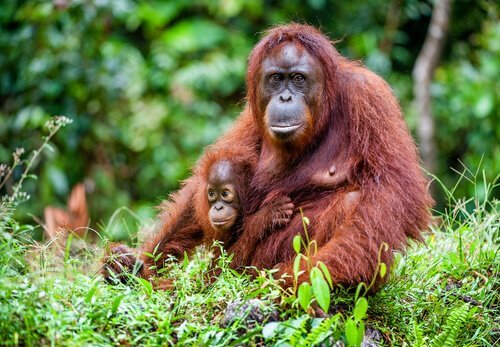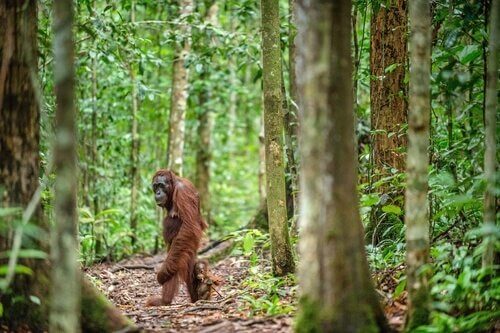Conservation Strategies of the Bornean Orangutan

The Bornean orangutan is officially in potential danger of extinction, according to a report by the IUCN (International Union for Conservation of Nature). Unfortunately, this means that efforts for their conservation during the last 50 years were unable to prevent it.
The most recent data released by a team of 38 international institutions suggests that, between 1999 and 2015, the total number of orangutans decreased by over 100,000. Consequently, this means that the species is disappearing faster than experts thought.
Regardless of the positive results of previous conservation efforts, the only significant objective wasn’t achieved: to stabilize or increase their population. Conversely, the sad reality is that there’s very little anyone can do to alter their decline.
Bornean orangutan: Causes of extinction

According to studies carried out by the IUCN, in 2010 only 59.6% of the Borneo rainforests were still suitable for orangutans. Furthermore, while much of this land is technically under the protection of the governments of Indonesia, Malaysia, and Brunei, the threats to this species linger on.
Of course, this is largely due to human activity. Some examples are:
- Intense illegal logging
- Conversion of forests into extensive oil palm plantations
- Mining operations
- Destruction of some forest areas for road construction
Conservation
The habitat of the Borneo orangutan is also harmed by large-scale fires, a consequence of the El Niño weather phenomenon. In addition, illegal animal trade influences the decline in this species. In addition to this, these specimens are food sources for some local tribes.
Alarming losses
In times gone by, there were hundreds of thousands of Bornean orangutans. However, according to current estimates, the total number has decreased by 50%. (The most recent and accurate figures are available on the IUCN website.)
The IUCN Red List of Endangered Species shows that some 14,600 Sumatran orangutans remain. On the other hand, the Bornean orangutan population currently has around 104,700 individuals.
The substantial loss of habitats on both islands suggests that the current figures are actually below the numbers on the IUCN Red List. Approximately, between 2,000 and 3,000 Borneo orangutans are killed each year, just in the past four decades.
The Bornean orangutan is an adaptive species

Orangutans, in general, are a highly sensitive species that can survive only in the most pristine ecological conditions. However, the more researchers learn about this species, the more they realize that these creatures are able to adapt to new environments.
For example, the Bornean orangutan walks on the ground more often than we previously thought. Furthermore, they can also eat plants that weren’t a part of their natural diets, such as acacia or oil palm.
Such behavior could allow them to survive in fragmented landscapes and in much smaller forest locations than previously thought possible. However, they can’t catch up with the high death rate observed today.
The Bornean orangutan is a very slow breeding species. Moreover, females only breed once every six or eight years. This makes it the longest birth interval of any terrestrial mammal, and further harms the recovery of the population.
Predictions of lower figures
There are protected populations in Borneo, parts of Malaysia, and some larger national parks in Indonesia. This would make it unlikely that the Bornean orangutan will be extinct in the near future. Even so, there’s an urgent need to prevent more deaths.
These days, around 10,000 orangutans inhabit areas assigned to the development of oil palm. We must address the hunting, killing among natives, and the collection of orangutans as pets through public disclosure.
At any rate, this would facilitate the resolution of conflicts in the communities and the application of the law. In terms of conservation, it’s essential to develop appropriate strategies that truly address the decline of the current population. In addition, more research is needed in this regard.
All cited sources were thoroughly reviewed by our team to ensure their quality, reliability, currency, and validity. The bibliography of this article was considered reliable and of academic or scientific accuracy.